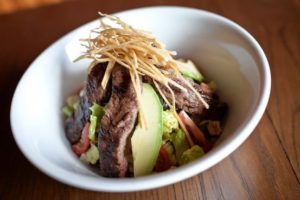
Independent restaurant chains shift to individual concepts. The biggest trend this year has put the spotlight on regional restaurant groups—talented restaurateurs like EMM Group, Lure Group, Major Food and Starr Restaurants—which are growing and thriving by opening very individual restaurant concepts. The traditional blueprint for success—create a successful dining concept and then replicate that same restaurant in other cities—is still being deployed, but is losing ground to the restaurateurs’  innovative desire to bring adventurous diners a new experience with every concept each restaurant group opens. Just like a good stockbroker, they are diversifying their portfolios. Lure Fishbar built its reputation on sushi and now wins over foodies with its Mexican concept, El Toro Blanco (pictured below). Every account in the group is distinct with its own personality and theme. With Major Food Group, the restaurants focus on the group’s expertise with Italian restaurants, but each concept is different in inspiration, menu, ambiance and design. The consumer may not know the two restaurants are related, and even if they did, it’s cool because the people behind their favorite restaurant
innovative desire to bring adventurous diners a new experience with every concept each restaurant group opens. Just like a good stockbroker, they are diversifying their portfolios. Lure Fishbar built its reputation on sushi and now wins over foodies with its Mexican concept, El Toro Blanco (pictured below). Every account in the group is distinct with its own personality and theme. With Major Food Group, the restaurants focus on the group’s expertise with Italian restaurants, but each concept is different in inspiration, menu, ambiance and design. The consumer may not know the two restaurants are related, and even if they did, it’s cool because the people behind their favorite restaurant  are bringing them a new dining experience as an alternative. That means more reasons for the guests to dine out within a single restaurant group and never get bored. So these groups are not like restaurant chains, but purchasing and other operations tasks are often handled like a chain. These restaurant groups are branching into different cities throughout the Northeast—Boston Restaurateur Ken Oringer is getting a lot of press for bringing his wildly popular Toro concept to New York—and, as a Boston resident, it’s exciting to watch all the restaurant cross-over that’s happening between these two cities. Small restaurant groups are also adding small boutique hotels to their portfolio. The creativity and entrepreneurship of my region’s restaurant owners is impressive and fun to watch.
are bringing them a new dining experience as an alternative. That means more reasons for the guests to dine out within a single restaurant group and never get bored. So these groups are not like restaurant chains, but purchasing and other operations tasks are often handled like a chain. These restaurant groups are branching into different cities throughout the Northeast—Boston Restaurateur Ken Oringer is getting a lot of press for bringing his wildly popular Toro concept to New York—and, as a Boston resident, it’s exciting to watch all the restaurant cross-over that’s happening between these two cities. Small restaurant groups are also adding small boutique hotels to their portfolio. The creativity and entrepreneurship of my region’s restaurant owners is impressive and fun to watch.
Go small or go home. Tiny restaurants are hip again. Petite restaurants are opening faster than bottles of Bollinger  at Jordan’s Halloween party. With only about 20 seats, these restaurants are proving that the economy of scale isn’t needed to run a successful business in the Big Apple; it seems like everything being smaller from the dining room and number of employees to the menus and kitchen is paying off for these avant-garde restaurateurs. Major Food Group’s Carbone (pictured right) is a great example. With its three dining spaces–each equally tiny, dark and intimate–Carbone feels more like a supper club from a bygone era. The menus are as tall as the New York Times, and the craft cocktails are even served in vintage glassware. Smaller, more intimate restaurants where time stands still…Put away your smartphones and embrace the throw-back movement. It’s here to stay.
at Jordan’s Halloween party. With only about 20 seats, these restaurants are proving that the economy of scale isn’t needed to run a successful business in the Big Apple; it seems like everything being smaller from the dining room and number of employees to the menus and kitchen is paying off for these avant-garde restaurateurs. Major Food Group’s Carbone (pictured right) is a great example. With its three dining spaces–each equally tiny, dark and intimate–Carbone feels more like a supper club from a bygone era. The menus are as tall as the New York Times, and the craft cocktails are even served in vintage glassware. Smaller, more intimate restaurants where time stands still…Put away your smartphones and embrace the throw-back movement. It’s here to stay.
Secret supper clubs on the rise. The next generation of pop-up restaurants is thriving in New York. They’re almost like a secret supper club. Foodies subscribe to a newsletter and get an email the day of the dinner with a location and time. These secret supper clubs are usually hosted in licensed venues and related to an existing restaurant. The big challenge for me, as a winery sales director, is trying to get Jordan wines featured at these types of dinners when everything about them is nomadic and secretive. Having relationships with those existing accounts affiliated with the supper club is key for a chance to have Jordan wine featured at the dinner.
Smaller wine lists that change constantly. Sommeliers and beverage managers have shifted to smaller wine lists that change more often. About 150 wines on a list is now the sweet spot for restaurants; customers are ordering 3-5 cases of a wine, and then, it’s time for a change. Restaurants are still offering popular varietals like Chardonnay, Cabernet Sauvignon, Merlot and Pinot Noir (both by the bottle and by the glass), but they are cutting back on the number of different labels carried. Gone are the days of long-term placements on a wine list. That’s more work for the sommelier and the sales rep—and more printing costs for wine lists, but digital wine list apps like Tastevin are giving sommeliers the flexibility they need when the wine list is changing weekly. The price range on wine lists is the biggest I’ve ever seen in my 12 years of wine sales—from $40 to $500 per bottle—and wine on tap is becoming the norm. Local wineries and smaller California producers are making wine kegs just for a specific restaurant group for a value-priced, by-the-glass pour to secure placements on these smaller, ever-evolving wine lists. Check out the wine lists at gastropubs like The Breslin, Burger & Barrel or DBGB. All are great examples.
 Unexpected food crazes. Move over cupcakes. The latest food craze in New York City is cronuts. A sort of croissant/donut hybrid that has been trademarked by baker Dominique Ansel, cronuts are sold every day, limit two per person, and people line up the night before to get their “cronut on.” Shake Shack is developing its own cronut, to much fanfare. Ramen noodle restaurants are also popping up all over Manhattan. New takes on the college-dorm-room-diet favorite focus on delicate noodles, fresh vegetables and savory broths served in hipster bowls. With the success of David Chang and his tiny, noddle-focused restaurants, no wonder inspiring chefs to hoping reinventing ramen could be the next big thing.
Unexpected food crazes. Move over cupcakes. The latest food craze in New York City is cronuts. A sort of croissant/donut hybrid that has been trademarked by baker Dominique Ansel, cronuts are sold every day, limit two per person, and people line up the night before to get their “cronut on.” Shake Shack is developing its own cronut, to much fanfare. Ramen noodle restaurants are also popping up all over Manhattan. New takes on the college-dorm-room-diet favorite focus on delicate noodles, fresh vegetables and savory broths served in hipster bowls. With the success of David Chang and his tiny, noddle-focused restaurants, no wonder inspiring chefs to hoping reinventing ramen could be the next big thing.


